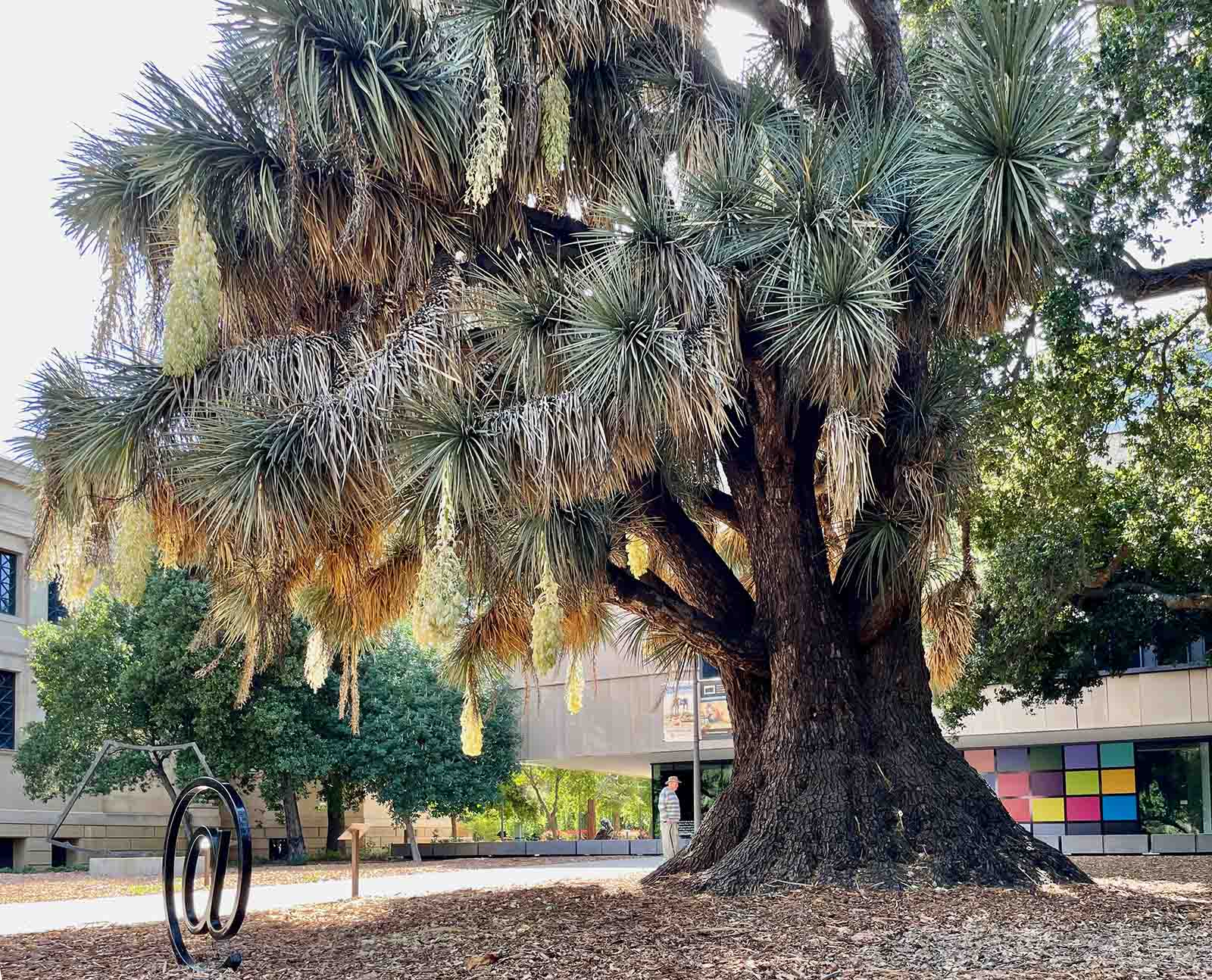Yucca filifera
 tree yucca
tree yucca
Unrivaled in California is our collection of majestic tree yuccas. Their hugely swollen bases and rosettes of sword-shaped leaves are impressive at any time of year. But to behold the clusters of creamy white flowers – many over a yard long – thickly drooping from their crowns is to see these relicts from the pre-University years in their resplendent glory.
Landscape designer Rudolph Ulrich went on collecting expeditions to Arizona Territory and Mexico in the early 1880s when designing and planting the Arizona Garden. The garden was adjacent to the site of a planned mansion for Leland and Jane Stanford. After their son died, the couple abandoned those plans, using the site instead for the family mausoleum (see p. XXX [for Arizona Garden sidebar]). The massive two-trunked specimen near the garden’s center lost one of its trunks in 2022. Another at the southern edge of the garden has a pronounced stoop, perhaps avoiding an oak that was subsequently removed.
It is the ancient specimen in front of the Anderson Collection, however, that was in 2023 christened national champion for size, for its species, by the California Big Tree Registry. It was saved during the construction of that building in 2013 and received the rare honor of its own sign in the process. Now towering to a height of more than 40 feet, it was very likely transplanted ca. 1899–1900 per Jane Stanford’s direction from the nearby Arizona Garden soon after the annexes to the Stanford museum were completed. (The annexes were later removed.) The striking cavity at its base, with fire-charred walls, has been present since at least the 1970s. Some sort of mechanical damage may have caused it. As to the fire, well, we do know that smoking was much more common on campus in former times.
Yet another enormous specimen grew on the grounds of Cedro Cottage near San Francisquito Creek, now the site of Oak Knoll Elementary School, Menlo Park. The cottage, set in richly elaborate gardens, was the home of one of Jane Stanford’s brothers and, subsequently, various early faculty and staff. Mrs. Stanford and little Leland had spent many happy hours at the bench of their favorite tree there, a giant oak festooned with a climbing rose. A 1985 photograph of the dramatically leaning yucca shows it to be nine feet across at the base and more than 35 feet tall. As with the museum specimen, Mrs. Stanford surely must have had it transplanted from the Arizona Garden. Or it may have been retrieved on one of Ulrich’s collecting trips. The school’s track area redesign in 2011–2012 prompted its removal.
Yucca filifera is native to the dry Chihuahuan Desert and loves heat. It has proven to be eminently suited to Stanford’s conditions. Curiously, very few comparable specimens exist elsewhere in the state. More should be planted for the enjoyment of the Stanford community in the next century.
Also see:
- The Cottage by the Creek. Peter C. Allen, Sandstone & Tile, Volume 9, No. 3, Spring 1985, Stanford Historical Society.
- Photo of Cedro Cottage tree yucca. Photographer: Peter C. Allen (likely), 1985.
Name derivation: Yucca – Haitian: yuca, or manihot, because young inflorescences sometimes roasted for food; filifera – (leaves) composed of or bearing thread-like structures.
About this Entry: Created by Sairus Patel (Aug 2024).





